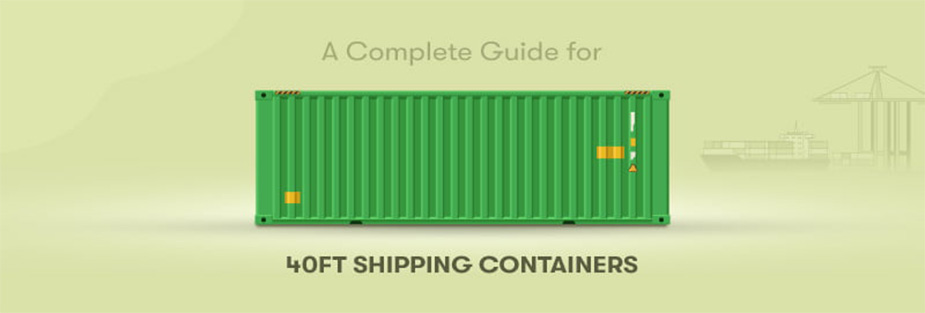
A Complete Guide for 40ft Shipping Containers
In the ever-evolving fields of transportation and logistical management, 40ft shipping containers are used as enormous examples of effectiveness, variety, and consistency. These recognized containers made of metal have revolutionized the way items are transported and maintained across the globe, guaranteeing an effective response to many challenges of business and trade across borders.
Starting with bustling ports in major cities to abandoned construction sites in remote landscapes, 40ft containers appear as silent workhorses, seamlessly transferring cargo across immense distances while serving as safe warehouse alternatives in even the roughest situations. In this detailed research, we will be taking a look at 40ft containers, encompassing their specifications, practice, and advantages, in addition to the many different ways in which they impact today’s global logistics scene.
Get A Free Quote!
Encourages the reader to request a no‑obligation pricing estimate for container relocation
Understanding 40ft Shipping Containers
A 40-foot shipping container is a traditional metal box that is utilized for the transfer of goods and storage of commodities. These containers coincide with ISO (International Organization for Standardization) rules and regulations, guaranteeing worldwide consistency and adaptability. These containers, which measure 40 feet in length, 8 feet in width, and 8.6 feet in height, possess a significant volume of all around 2,390 cubic feet, which makes them appropriate for storing many different kinds of commodities.
40ft shipping containers, frequently referred to as 40ft containers or 40 foot containers, are among the most commonly utilized standard sizes in containerized cargo transit around the globe. These containers are 40 feet (12.2 meters) in length and provide adequate space to transport an enormous quantity of manufactured goods efficiently.
Dimensions of a 40ft Container
The standard dimensions of a 40ft shipping container are as follows:
- Length: 40 feet (12.19 meters)
- Width: 8 feet (2.44 meters)
- Height: 8.6 feet (2.59 meters)
The dimensions listed above are steady across most 40-foot containers, ensuring seamless integration with a wide range of transportation methods that include ships, automobiles, and railways.
The traditional 40-foot container measures 12.2 meters (40 feet) long and 2.4 meters (8 feet) broad as well. And 2.6 meters (8 feet 6 inches) tall. This is capable of carrying a freight capacity of approximately 67.7 cubic meters (2,390 cubic feet). The shipping containers feature corrugated packaging steel sides and a pair of doors at one end, enabling it easy to load and unload products and materials.
The above parameters make 40-foot containers appropriate for transporting dense, substantial substances. A single 40-foot container might accommodate a good euro pallet filled to capacity. In comparison to the increasingly common 20ft container, the 40ft container provides nearly twice the capacity regardless of not being twice as big. This makes it desirable to supply significant amounts of commodities overseas or throughout continents via ships, trains, and trucks.
Applications of 40ft Containers
The adaptability of 40ft shipping containers allows them to be ideally suited to an extensive variety of applications:
- International Shipping: 40-foot containers are routinely used to move commodities via sea freight on cargo ships around the world. Their established dimensions facilitate optimal loading and stacking, maximizing the amount of cargo available on ships.
- Storage Solutions: These containers are suitable for both businesses and individuals seeking inexpensive storage. Whether storing items of inventory, machinery, or personal possessions, 40-foot containers transmit secure and weather-resistant storage.
- Construction and Housing: Enhanced 40-foot containers are progressively being utilized in construction projects and developments for housing. From on-site storage units to modular places of residence and office spaces, these containers enable flexibility as well as environmental responsibility in construction applications.
- Event Spaces: Innovative business owners transform 40-foot containers into pop-up stores, food stands, and places to hold events. Their modular constitute and mobility make them optimal for short-term installations at festivals, fairs, and corporate events.
Benefits of 40ft Shipping Containers
Investing in 40ft shipping containers offers several advantages:
- Cost-Effective: In contrast to traditional building or warehousing options, 40ft containers are a more affordable choice, minimizing both time and money.
- Durability: 40ft containers, composed of high-quality steel, have been constructed to withstand adverse environmental conditions, guaranteeing the safety and security of your cargo.
- Versatility: The flexible structure of 40-foot containers allows for uncomplicated customization and the ability to adapt to a wide range of applications, enabling unmatched versatility.
- Transportability: 40-foot containers have been developed for intermodal shipment and can typically be effortlessly exchanged between modes of transportation, resulting in more effective logistical management.
- Scalability: Businesses are able to expand their hours of operation by adding more 40-foot containers as needed, which leads to scalable storage or place of employment solutions.
Maximum Weight Limits
The moment executed internationally by water-based, an all-purpose 40ft container is restricted to a maximum weight of around 28,480 kgs (62,710 pounds). This weight allowance enables transporters to pack the containers more densely. These containers are extremely common around the globe due to their high weight limitations and greatest cubic capacity.
Some 40-foot containers have greater limits on weight or particularly confirmed flooring intended for extremely thick cargo. Nevertheless, the standard grade permits the majority of goods to be transported affordably.
Talk To Us Now
Common Uses
Because of their adaptability, 40ft standard containers can accommodate thousands of shipping requirements. They can be used for an assortment of applications, which include packaged final products, industrial equipment, electronic devices, household equipment, materials such as plastics and metals, milk and other dairy products, and more.
Many exporters of agricultural products prefer 40-foot reefer containers with refrigerated equipment for transporting fruits, vegetables, and meat. Particularly, Trained tank containers use the 40-foot frame for transporting liquids that include juices, wine, chemicals, medications, and other hazardous products that require safety containment.
In general, if the goods can be accommodated within the 40-foot box by means of its restricted access doors, they may be economically transported over long distances through containerships, commuter trains, and other modes to reach buyers both nationally and internationally. This has made 40-foot containers essential to worldwide trade over the past decades. They provide full intermodal transit flexibility irrespective of the cargo.
The article discusses some of the most significant components of 40ft shipping containers, particularly their dimensions, carrying capacity, weight restrictions, and the various kinds of items they move across countries and oceans regularly. 40-foot containers, whether or not wrapped in attractive layouts or just transporting safety packaging, are the workhorses that transport much of the global economy’s commodities around the world.
Conclusion
In conclusion, the comprehensive reference with regard to 40ft shipping containers draws attention to their significance in logistics and transportation. With standardized dimensions, plentiful storage space, and multiple uses, these containers have become vital assets for both enterprises and people. 40ft containers provide unmatched versatility and efficiency, aiding worldwide trade while also giving cost-effective storage solutions and inventive construction possibilities.
Considering the dimensions, potential applications, and benefits of 40ft shipping containers allows everyone to make informed decisions as they effectively utilize these assets. 40ft containers play an important role in improving efficiency, scalability, and sustainability in a variety of industries, including moving goods across oceans, storing inventory, constructing modular structures, and creating distinctive event venues.
Plan Stress-free Move with Top Moving Company in UAE - ISS Relocations

Frequently Asked Questions
How easy is How much does a 40ft shipping container cost?
The cost of a 40ft shipping container varies based on condition, location, and market demand. On average, a new Shipping Container can cost between $3,000 to $6,000, while used containers range from $1,500 to $3,500. ISS Relocations provides cost-effective shipping solutions for businesses and individuals.
How much is a 40 foot container in UAE?
In the UAE, the cost of a 40ft container depends on availability, type, and shipping requirements. Generally, new containers are priced between AED 10,000 to AED 22,000, while used containers are more affordable. ISS Relocations offers expert assistance in acquiring and shipping 40ft containers.
What is the cost of a 40 ft container in UAE?
The price of a 40ft container in the UAE varies due to factors such as demand, customization, and transport logistics. ISS Relocations helps clients navigate these factors, ensuring they receive the best rates and seamless transportation services.
How much can a 40 ft shipping container hold?
A 40ft container typically holds around 67 cubic meters of cargo, accommodating up to 25,000 kg in weight. It is ideal for international relocations, bulk shipments, and industrial equipment transport. ISS Relocations specializes in secure and efficient container shipping worldwide.
How many kg are in a 40 foot container?
A standard 40ft container has a payload capacity of approximately 27,600 kg, depending on the type and weight distribution of the cargo. ISS Relocations ensures the safe handling and transportation of heavy shipments within regulatory limits.
How much is a 40 container worth?
The value of a 40ft container depends on its condition, age, and modifications. New containers hold higher resale value, while used ones can be more budget-friendly. ISS Relocations provides expert guidance on choosing the right container for personal or business needs.
What is the capacity of a 40 foot shipping container?
A standard 40ft container has a capacity of about 67 cubic meters, making it suitable for large-scale shipments, furniture relocation, and industrial goods transport. ISS Relocations offers customized container solutions to ensure a hassle-free shipping experience.
How many cars can be shipped in a 40 ft container?
Typically, a 40 ft standard container can fit 2 to 3 average-sized cars (like sedans) depending on their dimensions and whether they are loaded with ramps or stacked using specialized equipment.
What are the 40 ft container dimensions, height, and CBM
A standard 40 ft container typically measures about 12.19 meters long, 2.44 meters wide, and 2.59 meters high, giving a total volume of roughly 67–68 CBM (cubic meters). The container height 40 ft high-cube version is taller, around 2.89 meters, which allows for slightly more internal space. These specifications help plan cargo efficiently, ensuring proper space utilization and safe loading inside the 40 ft container.
Moving Company - Recent Blog
Stay informed and prepared for your next move with our latest blogs on moving services in the UAE. From expert packing tips to international relocation guides, ISS Relocations brings you up-to-date insights to make your moving experience smoother, safer, and stress-free.










